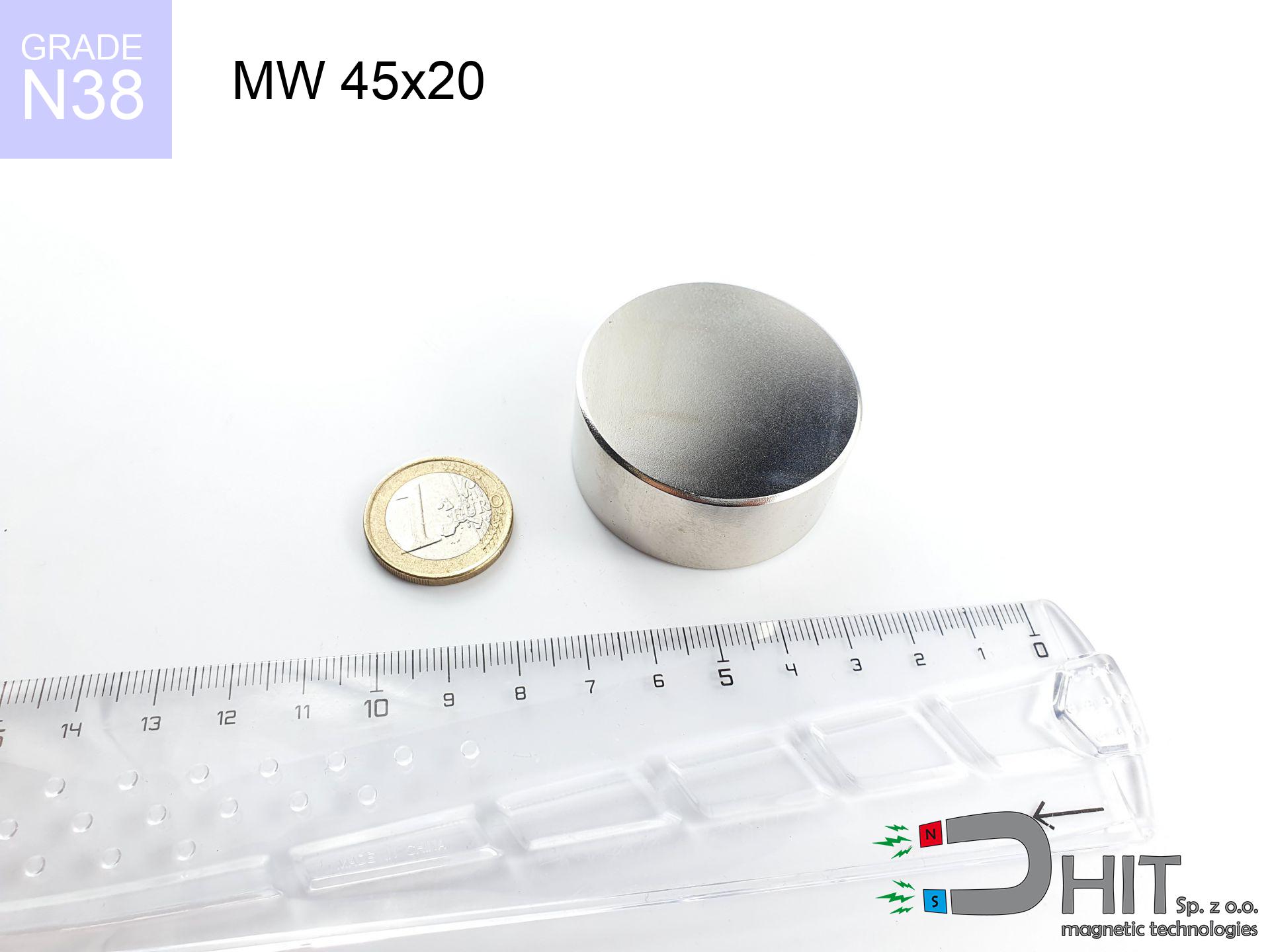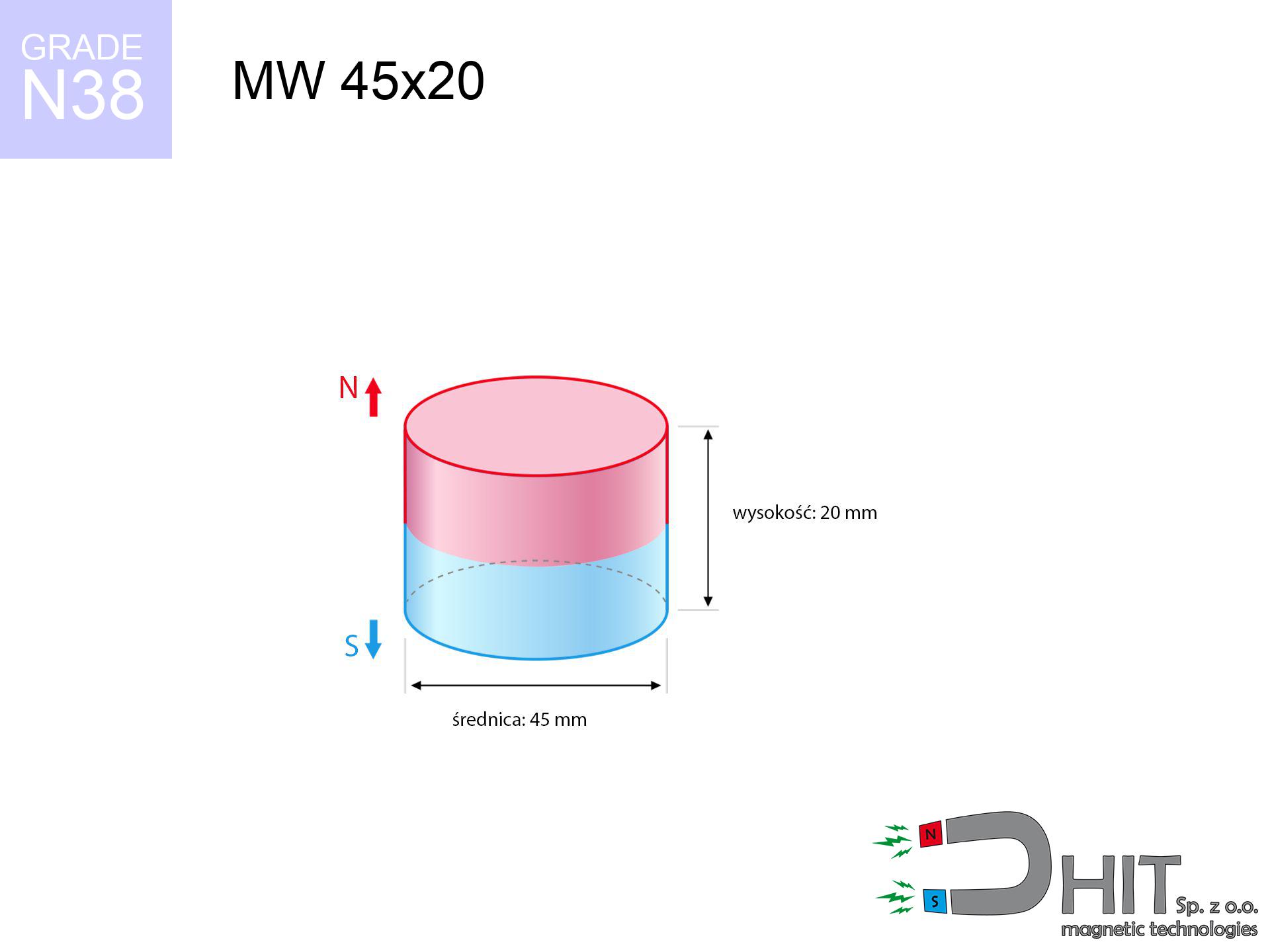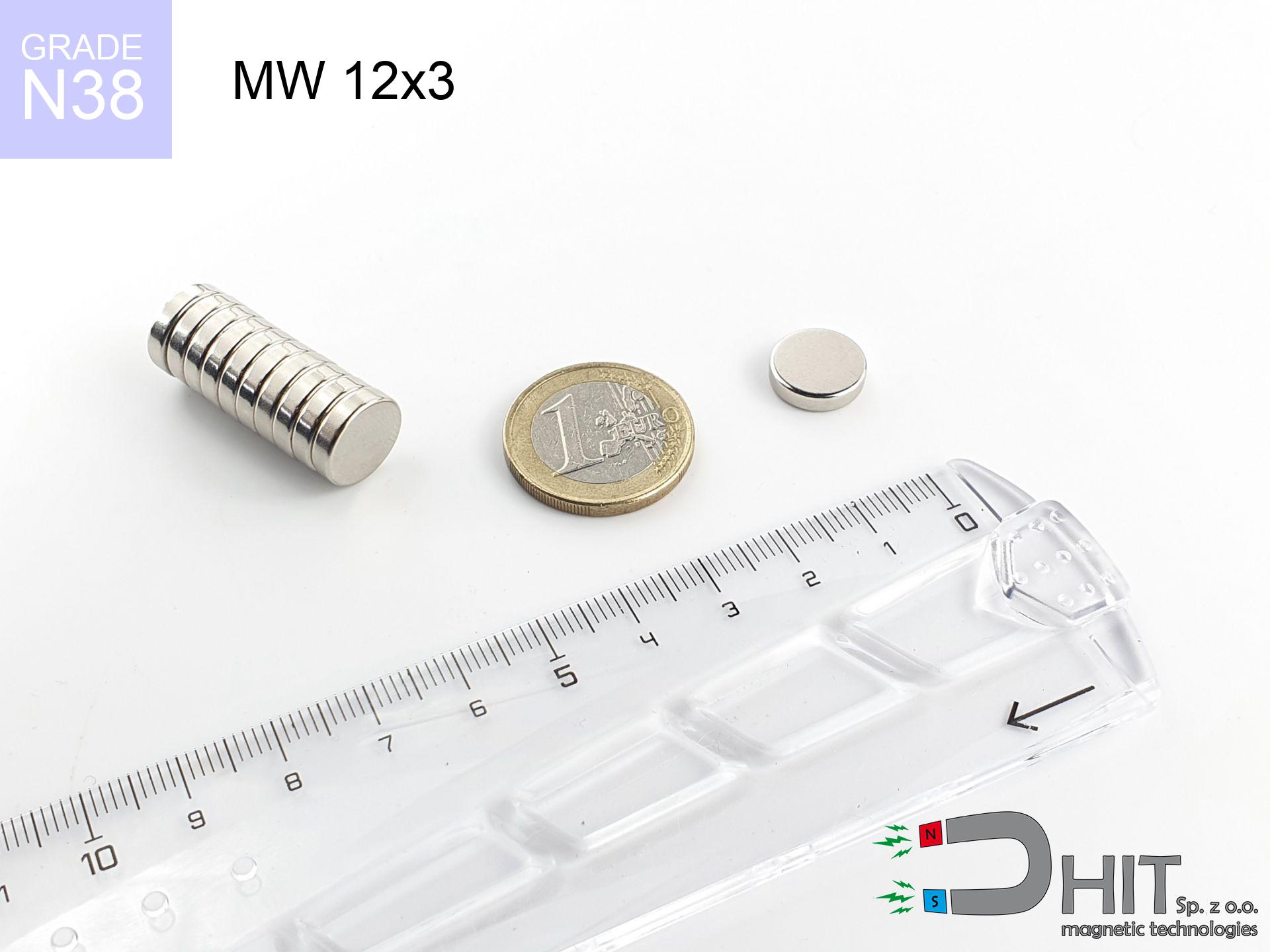MW 45x20 / N38 - neodymium magnet
cylindrical magnet
catalog number 010071
GTIN: 5906301810704
diameter Ø
45
mm [±0,1 mm]
height
20
mm [±0,1 mm]
magnetizing direction
↑ axial
capacity ~
49.76 kg / 487.98 N
magnetic induction ~
411.81 mT / 4,118 Gs
max. temperature
≤ 80
°C
catalog number 010071
GTIN: 5906301810704
diameter Ø
45 mm [±0,1 mm]
height
20 mm [±0,1 mm]
magnetizing direction
↑ axial
capacity ~
49.76 kg / 487.98 N
magnetic induction ~
411.81 mT / 4,118 Gs
max. temperature
≤ 80 °C
127.50 ZŁ gross price (including VAT) / pcs +
103.66 ZŁ net price + 23% VAT / pcs
bulk discounts:
need more quantity?Don't know what to buy?
Call us tel: +48 22 499 98 98 or write via form on our website. You can check the lifting capacity and the shape of neodymium magnets in our magnetic mass calculator magnetic calculator
Orders placed by 2:00 PM will be shipped on the same business day.
Specification: cylindrical magnet 45x20 / N38 ↑ axial
Magnetic properties of the material N38
Physical properties of sintered neodymium magnets Nd2Fe14B
Moreover, even though neodymium is a component of the strongest magnets, they are prone to corrosion in humid environments. Therefore, they are coated with a coating of nickel to protect them from corrosion. It's worth noting that NdFeB neodymium magnets are about 13% lighter than SmCo magnets and, despite their power, easily break, which requires special caution during their handling. For this reason, any mechanical processing should be done before they are magnetized.
In terms of safety, there are several recommendations regarding the use of these magnets. They should not be used in acidic, basic, organic environments or in solvents, as well as in water or oil. Furthermore, they can damage data on magnetic cards and hard drives, although data deletion using a neodymium magnet is not guaranteed.
In terms of properties in different environments, neodymium magnets are susceptible to corrosion, especially in conditions of high humidity. Therefore, they are often covered with coatings, such as silver, to protect them from external factors and prolong their durability. High temperatures exceeding 130°C can result in a reduction of their magnetic properties, although there are specific types of neodymium magnets that can withstand temperatures up to 230°C.
As for dangers, it is important to avoid using neodymium magnets in acidic conditions, basic environments, organic or solvent environments, unless they are adequately insulated. Additionally, their use is not recommended in water, oil, or in an atmosphere containing hydrogen, as they may forfeit their magnetic strength.
Compilation of suggested goods
Advantages and disadvantages of neodymium magnets NdFeB.
In addition to immense strength, neodymium magnets have the following advantages:
- They do not lose strength over time - after 10 years, their power decreases by only ~1% (theoretically),
- They are extremely resistant to demagnetization by external magnetic sources,
- In other words, thanks to the glossy nickel, gold, or silver finish, the element gains an visually attractive appearance,
- They exhibit extremely high magnetic induction on the surface of the magnet,
- By using an appropriate combination of materials, they can achieve significant thermal resistance, allowing them to operate at temperatures up to 230°C and above...
- Due to the option of accurate forming or adaptation to individual needs – neodymium magnets can be produced in various forms and dimensions, which expands the range of their possible uses.
- Key role in the industry of new technologies – are utilized in hard drives, electric motors, medical devices and very highly developed apparatuses.
Disadvantages of neodymium magnets:
- They can break as they are extremely fragile when subjected to a strong impact. If the magnets are exposed to impacts, we recommend using magnets in a protective case. The steel housing in the form of a holder protects the magnet from impacts and also increases its overall strength,
- High temperatures can reduce the strength of neodymium magnets. Typically, after heating above 80°C, most of them experience a permanent loss in strength (although it is dependent on the shape and size). To prevent this, we offer special magnets marked with the symbol [AH], which are highly resistant to high temperatures. They can operate even at temperatures up to 230°C, making them an ideal solution for applications requiring high-temperature operation,
- They rust in a humid environment - during outdoor use, we recommend using waterproof magnets, such as those made of rubber or plastic,
- The use of a cover or a magnetic holder is recommended due to the limited possibilities of manufacturing threads or complex shapes in the magnet
- Health risk associated with microscopic parts of magnets are risky, if swallowed, which is crucial in the context of children's health. It's also worth noting that tiny parts of these products have the potential to hinder the diagnostic process when they are in the body.
Safety Precautions
Keep neodymium magnets as far away as possible from GPS and smartphones.
Neodymium magnets produce intense magnetic fields that interfere with magnetometers and compasses used in navigation, as well as internal compasses of smartphones and GPS devices.
Neodymium magnets are particularly delicate, which leads to shattering.
In the event of a collision between two neodymium magnets, it can result in them getting chipped. Despite being made of metal and coated with a shiny nickel plating, they are not as hard as steel. In the case of a collision between two magnets, there can be a scattering of small sharp metal fragments in different directions. Protecting your eyes is essential.
Neodymium magnets are primarily characterized by their significant internal force. They attract to each other, and any object that comes in their way will be affected.
If have a finger between or on the path of attracting magnets, there may be a serious cut or even a fracture.
Neodymium magnets are over 10 times more powerful than ferrite magnets (the ones in speakers), and their power can shock you.
Make sure to review all the information we have provided. This will help you avoid harm to your body and damage to the magnets.
Do not place neodymium magnets near a computer HDD, TV, and wallet.
Neodymium magnets generate strong magnetic fields that can destroy magnetic media such as floppy disks, video tapes, HDDs, credit cards, magnetic ID cards, cassette tapes, etc. devices. They can also destroy videos, televisions, CRT computer monitors. Do not forget to keep neodymium magnets away from these electronic devices.
Do not give neodymium magnets to children.
Neodymium magnets are not toys. Do not allow children to play with them. They can be a significant choking hazard. If multiple magnets are swallowed, they can attract to each other through the intestinal walls, causing severe injuries, and even death.
Dust and powder from neodymium magnets are flammable.
Avoid drilling or mechanical processing of neodymium magnets. If the magnet is crushed into fine powder or dust, it becomes highly flammable.
Avoid contact with neodymium magnets if you have a nickel allergy.
Studies show a small percentage of people have allergies to certain metals, including nickel. An allergic reaction often manifests as skin redness and rash. If you have a nickel allergy, you can try wearing gloves or simply avoid direct contact with nickel-plated neodymium magnets.
Neodymium magnets can demagnetize at high temperatures.
Whilst Neodymium magnets can lose their magnetic properties at high temperatures, it's important to note that the extent of this effect can vary based on factors such as the magnet's material, shape, and intended application.
People with pacemakers are advised to avoid neodymium magnets.
Neodymium magnets produce strong magnetic fields that can interfere with the operation of a heart pacemaker. Even if the magnetic field does not affect the device, it can damage its components or deactivate the entire device.
Please see the article - What danger lies in neodymium magnets? You will learn how to handle them properly.



![magnetic accessories ucho [M12] magnetic accessories ucho [M12]](https://cdn3.dhit.pl/graphics/products/am-ucho-m12-maz.jpg)


![magnetic separator 25x175 [2xM8] / N42 magnetic separator 25x175 [2xM8] / N42](https://cdn3.dhit.pl/graphics/products/sm-25x175-2xm8-fux.jpg)

